It was in 1976 that I visited Jaisalmer for the first time, long time ago. Though the city is necessarily introduced in every guidebook now, it was almost a sleeping city forgotten from the world in those days. Only one night train was operated to that desert city from Jodhpur that is located on the edge of the Thar Desert. As the train was usually almost empty, I occupied a first class compartment by myself alone, starting for a long journey of ten hours to Jaisalmer, wrapped in a sleeping bag that I brought with me.
When I woke up in the morning, I found that the surface of everything in the compartment, such as the sleeping bag and floor, had become whitish, as if covered with mist. Minute grains of sand, which had slipped into the compartment during the night sprint of the train through narrow openings in its tightly closed window, had accumulated over everything like a membrane. It was a reminder that the train had been running in a genuine desert for a distance of 270km while I had been sleeping.
The train arrived at the terminal station of Jaisalmer at 8 ofclock in the morning. The platform lies in the center of a wasteland entirely covered with yellow earth, over which I saw an impressive fort rising up from a plain in the distance.
The station was located about two km from the town, but surprisingly there were no vehicles, not even a single taxi, waiting on the road continuing straight from the platform. At any town I had visited up to that time through my two-month journey in India, cycle-rickshaws or Tongas (horse-drawn carriages) used to wait in front of a station and scramble for passengers, but here, there were not any kinds of vehicles.
While I wondered how I was able to bring my baggage to the town, a child came and instructed me where to put it. In the direction he pointed, I found some low wooden platform trucks as large as about five square meters each. The passengers were throwing their goods or baggage on them as they liked. Those trucks were used to carry baggage into the town while passengers walked beside it. A number of children pushed the rattling trucks full of burdens, each of which operated on a fixed route. When arriving near onefs house, a passenger took his baggage, and gave some small money to a child.
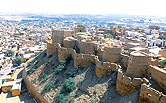 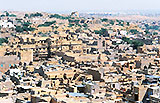
Citadel and town spread underneath
The only lodging facility for travelers in those days was a simple eTourist Bungalowf operated by the state government. Since it was located on exactly the opposite side of the town from the station, I had the farthest to travel.
Walking alongside the truck, and then sitting cross-legged on it as its baggage decreased, I traversed the town, looking at its streets, the fort, and arrayed town houses, wrapped in extreme surprise.
My impression of this town, which was sleeping almost as if dead, was like that of a medieval desert city abruptly reappearing in the 20th century, brought by a time machine, making me feel as if I were still in a dream in the night train. It was a fantastic world; a staunch citadel soared in the townscape, accompanying semi cylinder towers around its winding ramparts, and buildings on both sides of serpentine streets, not only temples and palaces but also even the small town houses were all made of yellow sandstone with minute carvings on their facades. It emerged out of an azure sky, shining in the morning sun, looking like a dream world.
 Townscape of Jaisalmer
Townscape of Jaisalmer
I had never expected that I would visit such a mysterious city, having no information about this city in advance; when I asked about the city at the Indian government tourist office in Ginza, Tokyo, all I was informed was that I had better investigate in Delhi before departing to Jaisalmer if India did a nuclear test or not just in those days.
Because India had carried out a nuclear test in the Thar Desert and that news was datelined Jaisalmer, the tourist office could only recall that fact regarding the city. Why then, did I intend to go to such a place? The purpose of my journey was actually not the town itself but its Jain temples.
One of my objectives on this first journey of mine to India was to visit as many holy places of Jainism as possible in three months, in spite of having very little information about them. Fortunately, that year, 1975, was the year of celebration of the 2,500th anniversary of the Nirvana or salvation of Mahavira, the founder of the religion. A now defunct thin pictorial touristic magazine, gYatri,hpublished by the department of Tourism of the Government of India, issued a special number focusing on eJain Shrines in India.f A luckily acquired copy of the magazine helped me know where the main pilgrimage places embracing Jain monuments existed; one of them was Jaisalmer.
There were no cars in the town. Since it is a compact city in the desert, people were able to go everywhere on foot, requiring no vehicles. When making a long journey outside the town, one rode a camel as in the past or drove a jeep, of which the town hall and tourist bungalow had one each. It was a solitary island floating on a desert sea. This city of medieval and yet opulent appearance was just an Indian Venice. Not only in their lack of cars but also in the fact that they are both once flourishing commercial cities that have now become museum-towns with tourism as their main industry, they can be regarded as sisters.
In order to know why this marvelous city had been left behind and has now newly appeared in front of us, it is indispensable to understand the notion of eRajput.f Western India consists of Rajasthan State in the north and Gujarat States in the south; eRajasthanf means the country of Rajput.
Tribes who had come from Central Asia since the 5th century and indigenous people in western India mingled together and formed a clan of a militaristic spirit. They became Hinduized, self-proclaiming as the offspring of ancient Kshatriya, or kings and warriors caste in the four Varna, and established many princely states at various regions in western India. Among them was a tribe who advanced to as far as middle India with the name of Chandella Dynasty, constructing splendid stone temples in Khajuraho.
However, it is the arid culture of Rajput clan in Rajasthan State that shows most sufficiently the typical image of India held by people around the world.
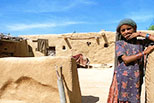 Earthen house and a girl at Chatrail village
Earthen house and a girl at Chatrail village
Batti Rajput, the clan that built Jaisalmer, originated in Punjab, a northwestern area of India, and the beginning of its dynasty goes back to the 6th century; tradition says that they are descendants of God Krishna!
In the age of the fifth king Batti, in 623, the clan commenced to call itself Batti after the name of the king. After having left Punjab to avoid the pressure from Islamic powerfs expedition to the east, the Batti clan wandered from place to place in the Thar Desert. In the 10th century they acquired the old city of Loderva in the center of the desert, and settled there. However, in 1026 Mahmud of Ghazna assaulted Loderva during its march to Somnath in Gujarat, and in 1103 Muhammad of Ghor attacked Loderva on the way to Gujarat and destroyed the town.
In response to the repeated attacks, Maharawal (King) Jaisal of Batti decided to abandon Loderva, which had been vulnerable to attacks and suffered insufficient water sources, and looked for land for a new town.
15 km from Loderva, he found a highly suitable site, which had a large depressed ground and a rocky hill despite being in the desert; the basin would be a water source and the hill would be an impregnable fort.
The king constructed his new town in 1156 and made people emigrate there, designating the town as Jaisalmer after his name. For 800 years after that, the town gradually developed due to the security of being located in the desert and its invulnerable fortress.
Rajputs established kingdoms in various regions in western India, such as Jodhpur by Rathore clan, and Bundelkhand, Mewar, Marwar, Bikaner, and so forth, and they came to fight with each other. Since these eRajput Warsf made regions in western India unstable, the Thar Desert turned into a relatively safe trade route between India and the West.
In addition, Jaisalmer had not been involved in the large wars of the 16th and 17th centuries, enjoying peace, so many merchants and bankers in various states immigrated to Jaisalmer as a safe refuge with their assets. The city became one of the financial centers in western India, like Switzerland in Europe.
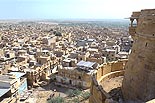 View of the yellow town from the castle
View of the yellow town from the castle
As the Islamic government of Mughals in Delhi ruledall of northern India, the Hindu kingdoms of the Rajputs gradually came to render homage to the Mughal dynasty. Jaisalmer also paid homage to Emperor Akbar in 1570, and Maharawal Harraj (1560-77) proffered his daughter to Akbar as one of his wives.
In this age of rapport between Muslims and Hindus in the 17th and 18th centuries, Jaisalmer was at the crest of its prosperity as a relay station of East-West trade.
The fall of the Mughals was also the beginning of the declining of Jaisalmer. Port cities build by Britain, such as Bombay and Calcutta, and sea trade, was rapidly developing, lowering the importance of caravan routes in the desert.
In 1818 Maharawal Mulraj II concluded a treaty with the British East India Company that Jaisalmer become a princely state under the British protection, which would continue up to Indiafs independence in 1947. When the construction of a network of railways by Britain connected Delhi and Bombay with the Sind region (the southernmost province of current Pakistan), Jaisalmer lost its position as the relay station of East-West trade.
When India became independent from the British Empire, the border with Pakistan was drawn 70km beyond Jaisalmer, depriving it of any possibility being a connecting route between the east and west.
It was 20 years before my visit to this town, which had thus become forgotten by the outside world, that Jaisalmer began slowly to be brought back to life as oil came to be extracted from the Thar Desert.
The epithet of the town, which citizens of Jaisalmer are most fond of, is ethe golden city.f Yellow sandstone quarried nearby is of good quality, shining yellow. The view of this town, every building of which, from palaces to town houses, was built of the yellow sandstone, and coupled with their opulently carved facades, Jaisalmer is worth being to be called the golden city.
It makes a nice contrast to the historical city of City of Fatehpur Sikri near Agra, because all the building in the latter, such as palaces and the great mosque, are made of red sandstone. The city was abandoned almost intact, due to the lack of water, and is a ghost town without people, while Jaisalmer is a living town where people still live. Between these two cities, both of which have equal fascination, it is out of balance to praise only Fatehpur Sikri in the history of architecture and ignore Jaisalmer.
Jaisalmer is located in the center of the Thar Desert, also called the Indian Desert, 600km from Delhi and 270km from Jodhpur, both of which are connected with Jaisalmer by narrow gauge railroads. While there is not a single river in the vast expanse of desert, rainwater during the monsoon is accumulated in various places in small ponds, each of which becomes a sole source of water supply for people living in the area, even though they are parched up in the dry season.
 Houses and a temple in the citadel.
Houses and a temple in the citadel.
The prosperity of Jaisalmer is owed to having been an oasis town on the camel caravan trade routes between the East and West. The city developed as a transit base to transport silks, spices, indigo, opium, and so on, through those routes connected to the Silk Roads. The target nations for trade were Persia, Arabia, Iraq, Egypt, and further up to African and European countries. Caravans used to stay in Jaisalmer to take a rest and resupply food and commodities, paying high tolls, which enriched the city and the Court.
Such a situation reminds us of the similar desert city of Palmyra on a caravan route in the Syrian Desert. The city prospered so excessively in the age of Hellenism as a relay town of the East-West trade that it was about to become independent from the Roman Empire. Therefore Palmyra was destroyed by Rome and its queen, Zenobia, was arrested and said to be dragged in the city of Rome as a pilloried criminal. While Palmyra exists now only as ruins, Jaisalmer is still a living town holding all buildings intact, even though not so old as Palmyra.
Jaisalmer attracted were not only merchants and bankers. As the Mughal Empire subdued northern India, Jaisalmer became a place of refuge for Hindus and Jains, and the disputes among Rajput states with each other made here a place of immigration for scholars and artists. Exquisite carvings on facades of buildings were contributed by craftsmen, stonemasons, and painters who had come from all over western India.
On the other hand, many caravan merchants lived in Jaisalmer during the rainy season and started out to various countries at the end of it, leaving their families behind. As a result, they created affluent literature, such as verses of parting from families, poems of longing for home, and songs of remote love.
As for the structure of the city, it is completely medieval. The streets were made spontaneously, and Baroque style town planning or rectilinear streets plan are not seen. It contrasts, within the Rajput world, with the city of Jaipur, which was made on a grid pattern. Despite geometrical figures shown as ideal towns in antique documents, there are hardly any actual examples. It was presumably after the advent of Islamic culture that city planning began in India. Even so, there are differences between the citadel of Jaisalmer and the surrounding lower town, in which the streets pattern is a little more like a grid, showing a gap between construction periods.
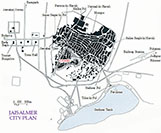 Map of Jaisalmer
Map of Jaisalmer
The lower city developed after 1722 in the reign of Maharawal Akhai Singh; all the buildings in it were constructed in and after the 18th century. As the town prospered with more population, the medieval citadel became insufficient to accommodate them. It was in 1750 that the ramparts surrounding the entire city were completed by Maharawal Mulraj II. The four city gates built through them were named Gadisar Gate, Amar Sagar Gate, Malka Gate, and Baron Gate. Unfortunately most ramparts have been carried away as construction material, leaving only a little in situ.
In comparison with other cities, Jaisalmer is conspicuous for its high density. Since the time the city made its boundary definite and surrounded the whole area with ramparts, necessary for a desert town to defend from invaders, its buildings had to be Manhattanized, restrained from spreading horizontally. It is remarkable that stone buildings are piled up in wooden-like framework structures without using any arches.
The yellow sandstone came from quarries near Loderva and Mul Sagar. The sandstone is easy to chisel and is hardened through exposure to the sun. The architecture of Jaisalmer is a mixture of that of Rajput and Islam, with little European influence. Houses have flat roofs owing to the scarcity of rainfall.
While the population of the city was 35,000 in 1815, it declined to under 10,000 by the early 1960s. However, the Indo-Pakistani Wars led to the importance of Jaisalmer to being recognized anew. Coupled with drilling for oil in the Thar Desert, the government began to construct the Rajasthan Canal and national highways. The railway to Jaisalmer went into operation in 1968 and the cityfs tourist bungalow opened in 1978.
In the middle of the 1970s the project of conservation and resuscitation of Jaisalmer started under the initiative of Prime Minister, Indira Gandhi. The population recovered, reaching 22,000 by 1981. Recently the city has been transfigured drastically as a tourist town.
A gSilpa Shasra,h or medieval Sanskrit treatise on architecture, classifies Indian forts into nine categories:
- Giridurga (Mountain-fort)
- Jaladurga (Water-fort)
- Dhanavanadurga (Desert-fort)
- Vanadurga (Forest-fort)
- Mahidurga (Earth-fort)
- Nurdurga (Man-fort)
- Misrdurga (Mixed-fort)
- Daivadurga (God's fort)
Though the latter half is a somewhat mythical assortment, the desert mentioned in the list must indicate the Thar Desert. Ranking the Desert-fort third might show that the Thar Desert was a contact point between India and the West, so forts defending India were thought to be highly needed there. The one that best possesses the nature of Desert-fort among those in Rajasthan state is Jaisalmer Fort, which is second oldest after Chittorgarh Fort.
 
Citadels of Jaisalmer and Calcassonne (France)
As a citadel that contains not only military facilities and the rulerfs palaces but also an inner town accommodating citizens, Jaisalmer reminds one of the citadels of Aleppo in Syria and Carcassonne in France. The citadel of Aleppo, on a rocky hill soaring amidst the city, has a similar composition to Jaisalmer, but no inner town remains apart from the ruins of mosques and palaces. Since the mediaeval city of Bagdad also no longer remains, Jaisalmer and Carcassonne seem to be the two greatest examples of citadels with complete defensive ramparts in the East and West.
The citadel of Jaisalmer was constructed in 1156 on Trikuta (three ridges) Hill soaring at a height of 76m above the desert plain. People transferred from Loderva erected earthen houses in the citadel, at first in an area of residents of the same caste. Between 1577 and 1623 three gates, the Suraj Pol (Gate of the Sun), Ganesh Pol (Gate of the Elephant God), and Hawa Pol (Gate of the Wind), were constructed. Suraj is Surya (Sun God) in Sanskrit and is applied to the name of a gate on the sunrise, or eastern, side. Above the portal of the Suraj Pol are carved sun discs and a Torana-arch as ornaments.
The ramparts were doubled, in higher and lower positions, between which are passages for patrolling sentries. According to R. A. Agarawala, the ramparts were made of accurately piled ashlar without any mortar. Among the impressive 99 semicircular Burjs (bastions), which makes the fort captivating in form, 92 were constructed from 1633 to 1647 for the purpose of providing batteries. The inner rooms of the bastions were used as sentriesf dwellings and armories.
Stone balls lining on the top of the ramparts are not embellishments but stone cannonballs used before the development of artillery. They were thrown down to enemies rushing to the ramparts.
 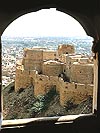
Citadel and its Suraj Pol (Gate of the Sun)
One enters the citadel through the Suraj Pol, then changes direction 180 degrees to go through the next gate, the Ganesh Pol, and walk up an ascent. The entrance to the inner town is the Hawa Pol, the upper floors of which are a part of a royal palace. In India it is not rare that a royal palace is located toward the front, rather than at the rear as in Europe or Japan.
When coming out of the tunnel-like gateway, one reaches the royal square. Although it lacks a formally planned character like Italian plazas, it is an informally shaped square used for various purposes such as an audience with the king and caravan markets. Streets in all directions from this square lead to citizensf residential areas, Jain temples, and the Castle Hotel.
The royal family of Jaisalmer is descended from the clan of Rathore Rajput who gained mastery over the Marwar region (the middle west of the Rajasthan State), and the royal family was called eRawal.f The king had been referred to as eMaha Rajahf (literally great king) as in other regions, but from the 11th king, Devraj, they called themselves eMaha Rawal.f It was this Rawal Devraj who took up his abode in Loderva, 15km from Jaisalmer.
The 17th king, Jaisal, transferred his base to Jaisalmer in the 12th century, constructing the citadel and inner town on the current Trikuta Hill. His palace must have naturally been built at that time, despite there being no remains nowadays. The palaces, which one can see at the present time around the royal square, were erected one by one from the 16th century to the 19th and were constantly maintained. As they are not freestanding but connected to each other, it may be more suitable to say that a single palace was constantly extended. Here they are enumerated in chronological orderF
- Zenana Mahal (Palace for wemen), 16th- 17th century
- Sarvottam Vilas, in the reign of Maharawal Akhai Singh (1772- 62)
- Rang Mahal (Palace of color), Maharawal Mulraj II (1762- 1820)
- Moti Mahal (Palace of pearl), Gaj Vilas, Gaj Singh (1820- 46)
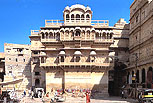 
Gaj Vilas, old palace in the citadel
The building that displays the most opulent semblance to the square in the citadel is the Gaj Vilas (Palace of Gaj). It puts a line of chatris over its two floor-high solid walls; further up is a continuous balcony with small curved roofs. On the top is an independent pavilion also capped with curved roofs. This splendid facade was cocmpleted at the end of the 19th century, before which the palace had worn a more simple and austere external appearance.
The Gaj Vilas was an extension of the older Mardana (quarter for men) at the rear. When looking carefully at the above photo of the Gaj Vilas, one can recognize that the back-facing walls (Mardana) and the facade on the right side (Zenana, quarter for women) are much more modestly finished.
According to G.H.R. Tilottson who researched the Rajput palace, the four storied building stretching at the rear of the Zenana Mahal, is probably the oldest palace, Juna Mahal. And he conjectured that the Moti Mahal was constructed after the Gaj Vilas, because the formerfs facade is almost a replica of the latterfs.
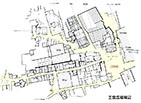 PLAN of the central part of the Citadel
PLAN of the central part of the Citadel
Seeing the palaces in chronological order, one can discern the alteration of architectural style at the end of the 17th century. Moving from the strong and sturdy to the decorative tallied with the cityfs economic development through collecting tolls as a relay post on the East-West trade. The enlargement and extension of palaces also had something to do with that fact.
Therefore, these palaces were not planned as a single unit. Jaisalmer palaces do not have a Chahar Bagh (quartered garden) or cloisters as seen in the Mughal palace quarters in Delhi or Agra Forts, nor disposition along axes. The lack of a master plan can be regarded as an Indian tradition before the advent of Islam, as also shown in the Jain temples quarter in the citadel.
In the latter half of the 19th century, the princely states of Rajput in Rajasthan under British protection came to adopt aspects of European culture. As the old palaces began to no longer match new life styles, various states built new palaces in European architectural styles. It was not rare to invite British architects to commission their designs, such as in Jodhpur and Baroda. Even Jaisalmer abandoned the palaces in the citadel and built new palaces in the lower town. However, in comparison with other states, they seemed to cherish their traditional architectural styles, accepting less westernization.
 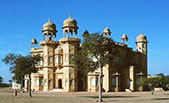
Jawahar Vilas, Jawahar Niwas
The new palace complex, constructed near the Amar Sagar Gate from the end of the 19th century to the beginning of the 20th, consists of two parts: Jawahar Vilas and Badal Vilas. Although the descendants of the royal family still live there, it was not easy economically to mentain their previous way of life after having lost their own princely state, which was incorporated into the Republic of India. Many royal families have converted their palaces to museums or hotels to provide incomes. Jaisalmer also is not an exception, converting the Jawahar Vilas and Jawahar Niwas to epalace hotels.f
 Tazia Tower of Badal Vilas
Tazia Tower of Badal Vilas
The most conspicuous building among the new palaces is the five storied observation tower of the Badal Vilas. As its form resembles a eTaziaf of Islam (a replica of the tomb of Hassan and Hussein), which is pulled through the streets on the festival of Muharram by Shiite Muslims, it is called the eTazia Tower.f It was actually built by Muslim craftsmen to dedicate to the Hindu king. It denotes that there was a harmony between Hindus and Muslims in Jaisalmer as well as in the architectural styles.
As for the Jawahar Niwas, it was constructed around 1900 by Maharawal Bairisal Singh for the British Resident to India at outside the city wall, initially referred to as the Ishal Bungalow. As it was much influenced by European architecture in spite of being made in the Indo-Saracenic style, Tillotson called it a eCountry house of Rajput.f It has been converted into a hotel since 1982, and I have spent some pleasant nights there.
@
Although the royal family of Jaisalmer had been Hindus for generations, there are no superb Hindu temples in the city and those that are architecturally valuable are all Jain. This fact indicates that successive kings were tolerant toward followers of different religions, Jainism or Buddhism, and that Jains had held the real economic power of Jaisalmer through East-West trade and banking.
Jainism has a 2,500-year tradition, retaining eAhimsaf (nonviolence) as its main doctrine. Its founder was Mahavira, and it was established in eastern India like Buddhism. When suffering a great famine around the beginning of the era, Jains are said to have moved to southern and western India. Now the largest number of them live in western India, where their finest architectural pieces also concentrate.
Jains have traditionally not engaged in the occupations of agriculture, fishery, military, and so on, in order to stick to the Ahimsa doctrine, taking up mainly commerce and banking for their business. Their success in those fields was so splendid that they gained a great economic power in spite of being a minority, only 0.5 percent of Indian population. Since such merchants have donated temples, Jainism possesses a disproportionally huge number of magnificent temples in relation to the number of its believers.
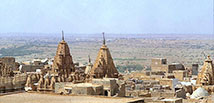 
Jain temples and Torana of Parshvanatha Temple
In the citadel of Jaisalmer there are eight Jain temples, each belonging to the Shvetambara (White Clad) sect, double the number of Hindu temples, showing how powerful Jain merchants were compared with the royals, despite being a minority in the city. Instead, Jains in Jaisalmer seemed to be humble to Hindus and sought to get along with them, arranging many carvings of Hindu gods in their temples.
Apart from the Mahavira Temple, which lies on a separate site, the other seven Jain temples are gathered in one place. They were not constructed at the same time, but in the following order:
- The Parshvanatha Temple (also called Lakshmana Vihara), 1417
- The Sanbhavanatha Temple, 1431 (also said to be 1420)
- The Chandraprabha Temple, 1452
- The Kunthunatha Temple (also called Ashtapadi Temple), 1479
- The Rishabanatha Temple, 1479
- The Shantinatha Temple, 1526
- The Shitalanatha Temple, 1547
  
Interiors of Sambhavanatha and Parshvanatha Temples
Like the royal palaces, they were constructed one after the other at intervals. Moreover their construction site was quite limited in the citadel; small pieces of land were probably added each time through purchase. So the temples are not necessarily composed in a complete plan; the traditional temple form was transformed to apply to each case. Such situations made them, so to say, eurban-typef Jain temples, quite different from other collective Jain temple groups, such as in Mt. Abu and Kumbharia. So the architects must have had as many troubles as those in current Tokyo.
The complexity of their construction, there is even a case in which two temples are connected at their upper floors crossing over a street, make the mutual relationships of the temples difficult to understand, though giving us varied and complicated space experiences in return. In order to make clear those mutual relationships, I surveyed them and made a comprehensive plan on the occasion of my third visit.
 Plan of the Jain Temples in the Citadel
Plan of the Jain Temples in the Citadel
The temple with the most complete form is the Parshvanatha Temple, which was first to be built. Although it has a sumptuous Torana (memorial gate) in the front.he distance from the entrance to the Torana and then to the templefs portal is too short to look at their whole appearance, due to its cramped precincts.
At both sides of the Parshvanatha Temple are very long and narrow temples on very small site, the plans of which are without parallel.
One more anomaly is that over the Kunthunatha Temple was later erected another temple, the Shantinatha Temple. This is also an extraordinary final resort only performed in an overcrowded city.
It is the Chandraprabha Temple that shows the most elaborate interior. Though small in scale, its high-rise interior of the Ranga Mandapa and Chatrumukha-type Garbhagriha (sanctum) reminds us of the great temple of Adinatha at Ranakpur.
Every temple was built in the Solanki style, which developed in the Gujarat region from the 10th century to the 13th, fundamentally the same as the Delwara Temples at Mt Abu. While the temples in Mt Abu were made of white marble, the temples here were of yellow sandstone, showing different tastes. Even so, when seeing those temples built in the same style continuing for hundreds of years all over western India, one perceives strongly the conservatism of the Indian people.
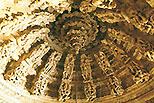 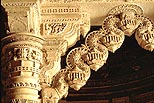
Details of Chandraprabha and Parshvanatha Temples
Apart from the architecture, what is noteworthy is the Gyan Bhandar in the basement of the Sambhavanatha Temple. A Bhandar is a kind of Jain library, which holds old manuscripts such as sacred scriptures and miniatures, set up in various places in Gujatar and Rajasthan. Gyan Bhandar was established by Pandit (sage) Jinabhadra in 1443. The other two Bhandars set up by the same pandit were said to be destroyed.
It is well known that not only Jain manuscripts but also many Sanskrit Buddhist scriptures were found in Gyan Bhandar. Their preservation in a pure state seems to have been possible because of being the Bhandar isolated in the desert. The oldest manuscript dates back to the 11th century and the total number of them attains to about 3,000; among which 500 were written on palm leaves.
Despite there being 2,700 Jain families in Jaisalmer before the Independence of India, now only 17 families remain. As the city was ending its role as an entrepôt of the East-West trade, Jain merchants also migrated to Bombay and other vibrant cities. While even now Jains account for 35 percent of the population of the city of Bikaner in the north; in Jaisalmer 60 percent are Hindus and 40 percent are Muslims.
Jaisalmer is a pleasant city, for peoples of different religions are friendly with each other without causing religious disputes, following the cityfs tradition of tolerance since its earliest times.
 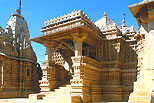
Parshvanatha Temple at Loderva
The older town of Loderva, Batti Rajputfs base before the move to Jaisalmer, was demolished in 1152 and again in 1615, without leaving any trace. Its temple dedicated to Parshvanatha was also destroyed but reconstructed in 1675 by a Jain named Thar Shaha. When I visited 20 years ago, it was in the midst of restoration work. It now shows its splendid appearance in the desert, along with its great Torana.
In Jaisalmer, not only monumental buildings such as palaces and temples, but also the common town houses which mainly compose the townscape are opulently embellished on their facades. From their walls usually protrude stone balcony crowned with canopies sustained with small columns. As every part of them is carved delicately, one could easily mistake all buildings for palaces.
Among those houses, particularly gorgeous ones are called eHavelis.f A Haveli, equivalent to a emansionf in English, is not necessarily of stone; there are also wooden Havelis in Ahmedabad and Baroda, while all Havelis in Jaisalmer were built of yellow sandstone.
 
Patwon-ki-Haveli in the lower town
As the town houses are crowded in dense districts, they are usually built in two or three stories, and it is not rare to see some even four or five stories high. Each plot is long and narrow with a small frontage, so they provide a courtyard to carry light down to each floor. Such a feature reminds us of Japanese traditional town houses in Kyoto, such as in the Nishijin district. However, their plans are not the Nishijin-type with a through passage, making instead its courtyard the heart of life as an open air living room, partly because of low rainfall and partly without distinction between inside and out due to the high temperature.
Their ground floor is usually half a floor up from the street, safeguarding the interior from dust and trash from the street, and occasionally from sandstorm in the desert, and also protecting the privacy of the house. This feature reminds us of town houses in London.
Such house composition is seen not only in Jaisalmer but broadly in western India, especially in the old quarter of the city of Bikaner, in the north of Jaisalmer, in a townscape of red sandstone houses.
The raised half floor facing the street is used as a storage space or repository of household waste, sometimes for public usage, helping keep the city beautiful. The inside could be a large semi basement room.
The upper platform, called eOta,f is a buffer zone between the town and house like a traditional Japanese eEngawaf (a boarded verandah along the outer side of a house). Family members sit here to work and chat with passersby. Since people of Jaisalmer are amiable and friendly, they spoke to me frequently when I was walking in the town.
There are three particularly famous Havelis in Jaisalmer. The most beautiful and largest is the Patwon-ki-Haveli, which was constructed in around 1805 by a Jain named Patwa Guman Chand for his five sons as five continuous houses. The Patwa family started as merchants for gold and silver craft work, and extended widely their business to trade and banking, spreading their power territory to the whole of western India.
As the site of this Haveli is also narrow, the building fully occupies the land, with protruding upper parts over the street in the same manner as in mediaeval Europe. A part of the building strides over the street, and the wall facing the street is full of oriel windows with curved roofs and exquisite carvings. Its appearance is so magnificent and luxurious that it even surpasses the royal palaces.
In the wake of the decline of Jaisalmer, the dwellers of the Patwon-ki-Haveli moved to another place and later the government purchased the Haveli to open to the general public. An upper floor was converted to a Sanskrit school, while the ground floor has become a shop for tourists in accordance with the growth of the tourist industry.
 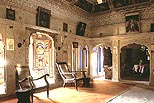 
Nathmal-ki-Haveli in the lower town
The Nathumal-ki-Haveli was built by a kingfs Diwan (minister), Nathumal, in 1885, the same period as the construction of the Badal Vilas Palace. Another account suggests that the king, Maharawal Bairisal, built it and gave it to the minister. It is currently occupied by an extended Hindu family consisting of as many as 24 members, suitable for the large mansion.
The Haveli is, like the Patwon-ki-Haveli, a five storied building with 40 rooms or so. The architects were Muslim brothers named Hati and Lalu who are said to have designed the right and left halves respectively. The living room in the second floor is colorfully decorated with wall paintings. The rear side of the site also faces another street, used as a utility area, providing a backyard and a stable for camels.
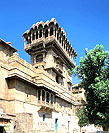 
Salim Singh-ki-Haveli in the lower town
Another splendid Haveli is that of Salim Singh, the mansion of the hereditary chief Diwan (minister) family of Mohta. Salim Singh is said to have abused tyrannical power more than the king so much so that many people fled the town. He was assassinated with poison in 1827 because of his extortion through heavy taxes.
Constructed to display his power in about 1815, ten years after the Patwon-ki-Haveli, this Haveli has a height rivaling that of the royal palace, showing baroque-like excessiveness and decadence. Due to its overly ambitious design with the top floor seeming to float in the air, because of which it is called the Jahaz Mahal (palace of ship), its eastern end was recently broken in a strong wind.
There are three main features in Jaisalmer architecture, which are most typical in such Havelis. The first is a latticed stone screen called a eJali.f It composes a strong wall with good ventilation like a Japanese wooden latticed screen, but with much more elaborate carvings. It was particularly used for the walls through which women in a Purdah (ladyfs room) were able to look outside, without being seen from outside.
The second is a decorative stone oriel window called a eJharokhaf that takes a brilliant role on the facades of buildings in Jaisalmer. The Patwon-ki-Haveli has as many as 66 Jharokhas in total. It seems that their meticulously carved parts, along with those of
Jalis, were prefabricated to some degree. That might be the reason that even a folk house could make its facade gorgeous, combining those prefabricated parts and adding more at any later date.
 
Jarokhas of Patwon-ki-Haveli
The final feature is the shape of roofs, especially of the canopies of balconies, that is boldly curved with both ends steeply hanging down. The origin of those omnipresent curved roofs in Jaisalmer can be traced back far away to the roofs of folk houses (Banglas) in the Bengal region in eastern India. In Bengal, including current Bangladesh, since it rains a lot, thatched roofs of such form has been popular from long ago, in order to shed rain as fast as possible, and the form was also adopted in temple architecture.
 
Folk houses and Hindu temples in Bengal
As Bengal was a granary region for the Mughal Empire, the Mughals, who had conquered the Bengal region, also carried this roof form back to Delhi and Agra to use it for their palace buildings. Rajput people came to be fond of this eBangardar Rooff and brought it to Jaisalmer.
It is an ironic story that a functional form in the area of high rainfall became a formative element in desert architecture.
Incidentally, a ebungalowf in English also means eBengali house,f but it does not seem to take this curved roof as a fundamental element.
Employing in plenty such a variety of architectural elements, the exuberantly embellished town of Jaisalmer surprises tourists by a kind of surrealistic formative artistic world. The nearest style of building to this would be the Hawa Mahal (Palace of the Wind) in Jaipur.
The Thar Desert is so enormous, of about 800 km in length and 320 km in width, that watering places are precious oases for travelers. The largest oasis is Jaisalmer. Most of the dotted small oases became villages, while some were made into gardens in the desert, the site of royal villas, and tomb gardens, by the royal family, and occasionally into farms.
Artificial ponds and lakes are called eSagarsf and they often dry up in the dry season. Even so, those places have at least some underground water and a few plants grow there, forming an oasis garden for people of the desert. The depth of the groundwater can attain to 30 to 130 meters.
Even though it is called a desert, the Thar is not all sand dunes. Sheep can eat shrubs that grow thanks to groundwater, so it is possible to engage in stock farming there.
 
Gadisar Tank and its pavilion
The water source for Jaisalmer is the Gadisar Tank (Lake) outside the city wall, though it is vulnerable to enemy attacks. However, the town also has underground water, providing wells in both citadel and lower town, though they are apt to be dried up in the dry season.
The Gadisar Tank, along with the citadel, was made in 1156 by Maharawal Jaisal, who deepened the naturally depressed ground and stored rainwater with embankments. After some severe damage, Maharawar Gharsi (Ghadsi) rebuilt it. The name Gadisar is a shortened form of eGhadsifs Sagar.f
Since the independence of India, the government has promoted the Rajasthan Canal Project to plant the desert with trees. The Indira Gandhi Canal was completed in 1987. Although drinking water has been drawn from Debala village 15 km away from Jaisalmer, women come to the Gadisar Tank to get water every day with golden pots on their heads. Since 1993, the water pipes have been supplied from Deha village, 40 km away; the tank does not dry up even in the dry season.
One passes through the Teelon Pol (Gate) to come to the Gadisar Tank. This gate was donated by a pious prostitute, Teelon, in order to contribute her wealth to society. She lived in Heyderabad (now in Pakistan) and used to come back to her native town, Jaisalmer, in every dry season.
Tradition says that courtiers were going to destroy this gate, discomforted by the source of the funds. To keep away this vandalism, she put an idol of the god Satyanarayana on the upper floor of the gate, disguising it like a temple, so nobody dared to destroy it.
Many temples and mausoleums surround the Gadisar Tank and some stone pavilions stand on the lake as if floating. Citizens would have enjoyed boating and taking a rest at those pavilions. It must have been an image of paradise for the desert people.
 
Jain temple at Amar Sagar
Seven km from Jaisalmer is the Royal garden and villa of Amar Sagar, named after Maharawal Amar Singh who founded it in 1688. The verdant garden facing an artificial lake is formed into a Charbagh (quartered garden) in the Islamic manner.
However, the most interesting feature in the current Amar Sagar is a Jain temple. Its first construction date is not clear due to various opinions, and it was under reconstruction at the time of my first visit 20 years ago. When I revisited nine years later, it was again under reconstruction; and surprisingly it was the same on my third visit nine years later. It was being reconstructed on a larger scale.
Contrary to the cramped temples in the citadel, the temple at Amar Sagar embraces an extensive internal rectangular hall, and the elaborateness of its carvings in the interior is so exquisite that it reminds us of the Alhambra in Spain. The masons brought from Agra are said to have worked here.
There is also a royal villa at the oasis of Mul Sagar, 9 km from Jaisalmer. It was built at the end of the 18th century by Maharawal Mulraj II. Although it has a fascinating space composition for walking around an extensive courtyard with surrounding cloisters, its architectural degree is not so high.
Hinduism holds the theory of transmigration of souls, that the dead are to be reborn 49 days later, so it does not make a habit of erecting tombs for the dead. However, after the advent of Islam, the habit of erecting tombs and mausoleums for kings and nobles gradually became popular in India. Hindu Rajputs were especially influenced by Islamic culture, vying with each other in erecting tombs for successive kings and their families.
Those graveyards were arranged like parks and open to the public, familiarized by people as tomb gardens. Particularly in Ahar near Udaipur, and in Gaitor near Jaipur, imposing tomb gardens were created. In Jaisalmer, royal tomb gardens were constructed on desert hills, showing strangely nostalgic landscapes. In addition to that, as those kingsf tombs include inscriptions showing their dates of construction, they are useful clues to trace the history of the kingdoms.
 
Chatris at Sunset Point and Bada Bagh
There is a hill called the eSunset Pointf to the northwest of the town of Jaisalmer. When coming here in the evening, one can get a beautiful view of the whole town in the light of the setting sun.
Here is a group of tombs called eVias Chhatris.f The word Chhatri originates in Sanskrit from eChattraf meaning umbrella, through the formal analogy of which a domical pavilion supported with four or more columns came to be called a eChhatri.f Smaller ones are used as decorative elements on a monumental building; larger ones are independently used as mausoleums, which have also been called Chhatris. Incidentally, in the Islamic world, a mausoleum is called a eQubba,f which originally means a dome in Arabic.
The graveyard of successive kings of Jaisalmer is the Bada Bagh in the desert, 5km away from the town. The Bada Bagh, literally meaning grand garden, was established in around 1513 by Maharawal Jait Sing II, and was named Jaitasar, after him, at the outset. He made it, along with a farm, with embankments, and it was completed by his son, Maharawal Lunkaran. There are many chhatris on its hill, which forms a fascinating view, and when citizens came here to picnic, they would take rest at these chhatris.
It can be said that the architecture of Jaisalmer was not necessarily the creation of new styles, but the sophistication of traditional architecture that had been developed in western India and the outcome of the maturity of a regional culture. What astonishes visitors is that such a splendid world, a esquandering of surplus,f so to say, exists in the middle of a remote desert like a mirage.
The microcosm, where every building of this human-scale town is made of the same yellow sandstone, embellished in the same ornamental style, might be a fleeting and unfinished dream for architects who visit here.
When looking closely at the forms and details of stone buildings in Jaisalmer, one will notice that they are more similar to the subtle wooden palaces in the Kathmandu region in Nepal than to the magnificent stone masonry monuments in Persia or Rome. Although there is a difference between Kathmandu and Jaisalmer, one has sloping roofs and the other flat roofs due to the large variance in precipitation, the two exceedingly resemble each other in their multi storied composition, sculptural details, and their oriels, to the degree of incredibility that two such similar architectures could be made from such different construction materials, wood and stone.
 
A Balcony of a Town House in Jaisalmer and an Oriel in Nepal
  
A Column of a temple in Loderva and Wooden Palace in Nepal
This indicates straightforwardly the formative principle of Jaisalmer architecture: in spite of being masonry structure, all buildings in Jaisalmer are fundamentally of wooden-origin. In the palaces, temples, and Havelis, the basic principle of masonry, the arch, is not used, but rather they are built in the wooden-like post-and-beam structure. Even the temple halls and domical roofs of tombs are not made using the arch-principle but the corbeling system of Indian tradition. And carving patterns suitable to wood are applied to stone components without any alteration.
It is quite valuable that the city composed entirely of buildings of such style, which are not seen outside India, remains intact just like in the mediaeval age. It is a precious cultural heritage not only for India but also for the world.
During the last 20 years, Jaisalmer has become almost the second Kathmandu in accordance with the rapid development of the tourist industry. Trains go to Jaisalmer from Jodhpur day and night every day full of passengers. Nowadays, a private air company flies regular flights to connect Jaisalmer with Delhi, Jaipur, and Jodhpur a few times a week.
Though Jaisalmer was a city without any cars and signboards 20 years ago, now its main streets are full of cars and signs, and a lot of houses have become shops and hotels.
Even so, as the scale of the town is still small without enormous hotels, the capacity of tourists is not large, allowing tourists the possibility of appreciating the traditional taste of the city. Among three old towns in the Kathmandu region, the town of Bhadgaun is comparatively well preserved and developed in a good balance, with the support of Germany. I wish Jaisalmer could also be preserved like that.
 The special Jaisalmer issue of the architectural magazine "at"
July, 1995, Delphi Institute, Tokyo.
The special Jaisalmer issue of the architectural magazine "at"
July, 1995, Delphi Institute, Tokyo.
- JAISALMER, City of Golden Sands and Strange Spirts, Bindu Manchanda, 2001, Harper Collins, India, B5-170ppD
- HISTORY, ART & ARCHITECTURE OF JAISALMER, Ram Avatar Agarawala, 1979, Agam Kala Prakashan, Delhi, A4-150pp.
- HISTORY OF JAISALMER, R.V. Somani, 1990, Panchsheel Prakashan, Jaipur, A5-240pp.
- ART & ARCHITECTURE OF JAISALMER, Sureshwara Nand, 1990, Reserch Publishers, Jodhpur, A5-150pp.
- JAISALMER : N.K. Sharma, Seemant Prakashan, Jaisalmer, A5-80pp.
- ANNALS AND ANTIQUITIES OF RAJASTHAN, or the Central and Western Pajpoot States of India : James Tod, 1829- 32
- ARCHITECTURE IN INDIA, Ministere des relations exterieures, 1985, Electa Moniteur, Paris
- THE HISTORY OF ARCHITECTURE IN INDIA, Christopher Tadgell, 1990, Architecture Design and Technology Press, London
- ANCIENT AND MEDIAEVAL TOWN-PLANNING IN INDIA, Prabhakar V.Begde, 1978, Sagar Publications, New Delhi
- ASPECTS OF CONSERVATION IN URBAN INDIA, Sten Nilsson (ed.), 1995, Lund University Press, Sweden
- JAINA ART AND ARCHITECTURE, A. Ghosh (ed.), 1974, Bharatiya Jnanpith, New Delhi, 3vols.
- RAJPUT ART AND ARCHITECTURE, Hermann Goetz, 1978, Franz Steiner Verlag, Wiesbaden
- THE RAJPUT PALACES, 1450-1750, G.H.R. Tillotson, 1987, Yale University Press, New Haven
- THE PALACES OF INDIA, Virginia Fass, 1980, The Vendome Press, New York
- THE FORTS OF INDIA, Virginia Fass, Christopher Tadgell, 1986, Collins, London
- THE TRADITION OF INDIAN ARCHITECTURE, G.H.R. Tillotson, 1989, Yale University Press, New Haven
- FORMAL STRUCTURE IN INDIAN ARCHITECTURE, Klaus Herdeg, 1990, Rizzoli
- THE PENGUIN GUIDE TO THE MONUMENTS OF INDIA, George Michell, Philip Davies, Penguin Books, London, 1989, 2vols.
- INDIA [A Travel Survival Kit] , Geoff Crowther, 5th ed., 1993, Lonly Planet, Australia
- GUIDE TO RAJASTHAN, India Tourism Development Corporation, 1975, New Delhi
- JAISALMER, Raj Rewal & Architectural Reserch Cell, MIMAR, No.20 (April - June, 1986), p.69- 78
- JAISALMER, INDIA, Kulbhushan Jain, A+U, February, 1977, p.13- 24
|




















































